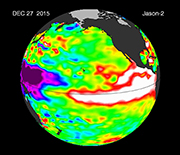News Release 18-039
To forecast winter rainfall in Los Angeles, look to New Zealand in the summer
Scientists find new 'teleconnection' for early and accurate precipitation prediction

Many California farms need intensive irrigation to maintain their crops.
June 13, 2018
This material is available primarily for archival purposes. Telephone numbers or other contact information may be out of date; please see current contact information at media contacts.
Variability in El Niño cycles was long considered a reliable tool for predicting winter precipitation in the Southwest United States, but its forecasting power has diminished in recent years.
In a study published today in Nature Communications, National Science Foundation (NSF)-supported scientists at the University of California, Irvine (UCI), have found a new method to project wet or dry conditions for the winter ahead.
"Influences between the hemispheres promise earlier and more accurate prediction of winter precipitation in California and the Southwest U.S.," said study co-author Efi Foufoula-Georgiou of UCI. "Knowing how much rain to expect in the coming winter is crucial for the economy, water security, and ecosystem management of the region."
Added Tom Torgersen, director of NSF's Water, Sustainability and Climate Program, which funded the research, "Predicting drought in the Southwest U.S. is a critical issue for food production and local economies. The discovery of an interhemispheric bridge that influences the U.S. winter jet stream holds the promise of improved precipitation predictability and drought forecasts."
The researchers call the new 'teleconnection' the New Zealand Index (NZI) because the sea surface temperature anomaly that triggers it begins in July and August in the southwestern Pacific Ocean near New Zealand.
The heating or cooling of the sea surface temperature there causes a change in the southern Hadley cell, a zone of atmospheric circulation from the equator to the 30-degree south parallel.
In turn, the Hadley cell change causes an anomaly east of the Philippine Islands, resulting in a strengthening or weakening of the jet stream in the Northern Hemisphere. That directly influences the amount of rain that falls on California from November through March.
In conducting the research, an interdisciplinary team from UCI's Department of Civil and Environmental Engineering and Department of Earth System Science performed an analysis of sea surface temperatures and atmospheric pressures from 1950 to 2015 in 1- and 2-degree cells around the globe.
"With the NZI, we can predict the likelihood of above- or below-normal winter precipitation in the Southwest U.S.," said lead author Antonios Mamalakis of UCI. "Our research also shows an amplification of this newly discovered "teleconnection" over the past four decades."
Mamalakis said that the most unexpected result is the discovery of persistent sea surface temperature and atmospheric pressure patterns in the southwestern Pacific that show a strong correlation with precipitation in Southern California, Nevada, Arizona and Utah.
Researchers have traditionally relied on a handful of globe-spanning oceanic and atmospheric conditions to help them forecast future precipitation. Gradual changes in sea surface temperatures in vast regions of the Atlantic and Pacific oceans influence the jet stream. Along with high pressure ridges over the Gulf of Alaska and El Niño, all are players in precipitation prediction.
In recent years, however, El Niño conditions did not bring heavy rains to California as they have in the past. This usually arid region, however, did receive heavy precipitation in the winter of 2017, considered a neutral El Niño year. The answer may lie in the interhemispheric bridge.
-NSF-
-
Almost no rain here: Death Valley, one of the most extreme environments in California.
Credit and Larger Version -
An intense rainstorm sweeps across wide-open Arizona lands.
Credit and Larger Version -
View of the San Luis Reservoir in Southern California; it almost reached capacity in 2017's rains.
Credit and Larger Version -
Heavy precipitation streams into California on the moisture flow called the "Pineapple Express."
Credit and Larger Version -
A recent, strong El Niño, especially visible at the equator, as seen on a satellite image.
Credit and Larger Version
Media Contacts
Cheryl Dybas, NSF, (703) 292-7734, email: cdybas@nsf.gov
Brian Bell, UCI, (949) 824-8249, email: bpbell@uci.edu
The U.S. National Science Foundation propels the nation forward by advancing fundamental research in all fields of science and engineering. NSF supports research and people by providing facilities, instruments and funding to support their ingenuity and sustain the U.S. as a global leader in research and innovation. With a fiscal year 2023 budget of $9.5 billion, NSF funds reach all 50 states through grants to nearly 2,000 colleges, universities and institutions. Each year, NSF receives more than 40,000 competitive proposals and makes about 11,000 new awards. Those awards include support for cooperative research with industry, Arctic and Antarctic research and operations, and U.S. participation in international scientific efforts.
Connect with us online
NSF website: nsf.gov
NSF News: nsf.gov/news
For News Media: nsf.gov/news/newsroom
Statistics: nsf.gov/statistics/
Awards database: nsf.gov/awardsearch/
Follow us on social
Twitter: twitter.com/NSF
Facebook: facebook.com/US.NSF
Instagram: instagram.com/nsfgov





